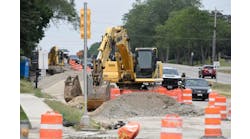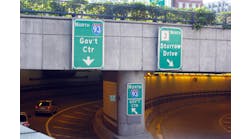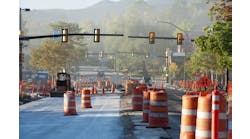New technologies and data analysis methods, many of them developed over the past 10 years or so, are helping to give geotechnical engineers working on projects with road planners new options in how they design their roadways.
It is now possible to safely make deeper, steeper rock cuts, and in some cases push roads through challenging rock masses that may have been considered “no-go” areas before. Benefits include:
- Lower highway grades, which is of increasing importance in light of the need to reduce the fuel consumed and air pollution generated as vehicles, particularly transport trucks, climb a steep grade;
- Straighter roads and wider curves for higher design speeds;
- Less risk from rockfalls and landslides, for greater driver safety, lower maintenance costs and fewer traffic delays;
- Less rock to move during construction and a smaller surface area for the rock cut, which reduces the environmental footprint of the project and reduces construction costs; and
- Greater predictability in construction, with less reactive design and delay as plans are reconfigured to cope with unexpected rock conditions, for faster, less-costly construction.
What’s different? It’s a basket of technologies, from various disciplines, that adds up to a whole new set of possibilities.
Watch how they act
The behavior of a rock mass is more easy to predict partly due to better data.
Drilling data can be integrated with geophysical data, particularly in sections where core recovery is inadequate or core loss occurs because of highly fractured rock—areas that sometimes led to overly conservative designs in the past.
Optical televiewer and acoustic televiewer logging methods give a picture that helps fill in the gaps between core samples. While borehole televiewers and other borehole-logging techniques have been used since the 1960s, originally in the oil and gas sector, there has been steady improvement in the quality of equipment, electronics and the range of data collected. Images generated about the rock mass may be able to show that, for example, concerns raised by the core samples are unwarranted, because the drill happened to hit a nexus between bodies of rock.
Better field mapping methods and better methods to statistically reduce these data are in use these days. This characterization allows for the development of geological models that can be used in computer modeling.
Better data leads to better decisions, so that there is less need to over-engineer, such as by cutting back the slope further or install excessive rock-stabilization measures. There also is less need to avoid questionable rock masses because of uncertainty regarding stability, so that roadway designers have more options regarding the routes they choose.
What-if performance
Better data availability and analysis combines with improved modeling software to produce detailed, realistic models that help predict the behavior of rock masses. These models provide guidance that goes beyond an individual’s experience of what works—and beyond best practice—to provide a realistic picture of potential failure mechanisms that is based on local conditions. More data helps build a more complex, realistic model.
The increasing prevalence of three-dimensional models provides a more understandable view of the rock mass, so it is easy to see how rock bolts, anchors and other measures will be positioned and how they will perform.
Better models allow designers to perform more “what-if” tests to try different scenarios to determine the most workable solution.
These developments are made possible in part through the greater availability and increasing affordability of high-speed desktop computers. Instead of running scenarios overnight, changes to assumptions can be tested in minutes or seconds. Greater ease of operation of the software and hardware means that more staff is able to do this part of design work for faster turnaround on projects.
With better understanding of rock mechanics gained through more dependable models, it may be possible to design steeper slopes and deeper cuts with confidence that the results will be safe and stable.
Having an accurate picture of the underground environment before the first excavation equipment gets to work has several advantages. One is that with fewer underground surprises, there is less need to stop work and redesign based on unexpected factors such as heavily fractured rock that was missed in the drilling program.
Less redesign allows for faster completion of projects, less disruption to traffic and to more satisfaction among stakeholders.
Holding back
There have been significant improvements in ways to stabilize rock slopes, using techniques such as bolts, anchors and shotcrete, and advances in ways to mitigate the risk of rockfall, an issue common to aging infrastructure. These advances come partly through computer-based analysis of spatial distribution and trajectories. They also come through better materials science and design around ring nets, wire mesh, impact fences and other barriers designed to catch or redirect falling rocks before they have a chance to cause problems for drivers. Perhaps 10 years ago, most fences would not be able to withstand an impact of 1,000 kilojoules; now materials can stand up to as much as 5,000 kilojoules of impact.
Particularly in Europe, there have been advances in the design of concrete sheds over roadways, able to withstand 10,000-kilojoule impacts.
Without going over
Better science and technology are often able to provide a better outcome than traditional design methods and best practice based on literature. Better science and technology can help identify cost-saving opportunities rather than the common solution to uncertainty of over-engineering, which adds to budgets and timelines, and it is possible to point to where money must be spent and where it can be saved.
Judicious spending is particularly important during financially constrained times. Where there is public money available for infrastructure developments, there are generally many controls regarding how it is spent and many stakeholders watching the process.
Accordingly, it is important to demonstrate not just the safety of public projects including road construction and improvements, but their fiscal responsibility as well. Here, too, technology improvements can help. While many legislators, members of the public and other stakeholders might have difficulty interpreting a line drawing such as a cross section or elevation, they find it easier to understand a computer-generated visualization, a three-dimensional model on screen or a computer-based “fly-through.” All these techniques can help them understand the risks involved in the project and the mitigation measures being taken.
Appropriate use of professional counsel, brought in during the early stages of the project, can help develop a good outcome that considers the options available given the current state of the art to develop an outcome that meets the needs of all concerned.
SIDEBAR
King of the Bluff
Before the creation of the Interstate Highway System, Highway 14 in southern Minnesota served as a major artery, stretching more than 1,400 miles and linking Chicago to Yellowstone National Park in Wyoming.
Also known as the Black and Yellow Trail, Highway 14 has brought travelers to some of the nation’s most-visited historical sites, including Badlands National Park, the Black Hills, Mount Rushmore, Devils Tower and eventually the eastern gates to Yellowstone National Park.
Now more than 80 years since its inception, Highway 14 is receiving some much needed attention between Lewiston and Stockton, Minn. The topography in this area features steep inclines and bluffs as it approaches the Mississippi River. Many of these bluffs were cut back to make room for the highway.
“When the highway was constructed back in 1926, they didn’t cut back the bluffs very far—just enough to get a road by,” said Deon Donlan, project manager for Reilly Construction, based in Ossian, Iowa. “As a result, the lower portion of one of the bluffs along Highway 14 has gradually eroded over the past 80 years.”
In fact, the lower 60 ft of the bluff along Highway 14 is composed of sandstone, a fine sand-like aggregate, and the erosion of the sandstone has created a significant overhang above the road.
Southern Minnesota experienced substantial flooding during the fall of 2007, and as a result the Minnesota Department of Transportation (Mn/DOT) was able to acquire federal funds to remedy the situation. So the project was let and Reilly Construction won the bid. However, Reilly knew from the beginning this was not going to be a typical project.
“There were multiple challenges with this project,” said Donlan. “The first 40 ft of the bluff featured a lot of cobble and dirt while the remainder was composed of solid rock, similar to limestone in 4- to 6-ft layers.”
Another challenge was that the top of the bluff was 160 ft above the highway, and getting equipment to the top proved to be quite an obstacle, considering the flattest part of the access area to the bluff was a 2-to-1 slope.
Estimators for Reilly Construction scouted the project site and took into account that Mn/DOT originally stated the project should be drilled and shot. However, due to the accelerated design and completion schedule, and the difficulty in reaching the top of the bluff, there was no time to adequately test the composition of the rock. So the estimators came back with a different approach.
Before any work could begin, Mn/DOT shut down a 12-mile section of Highway 14 and rerouted the traffic onto local county roads. Once the road was closed, Reilly Construction laid a 4-in. layer of sand over 2,000 linear feet of the highway surface.
Then a 4-ft layer of clay, sourced from a local farm, was placed over the sand to protect the road from damage due to the falling rock.
Next, Reilly cleared 3 acres of oak trees in order to establish a bench on top of the bluff. The company hired a contractor who owns a logging skidder to crawl up the slope and drag down the trees. Then Reilly moved its excavator up the slope.
“Everyone thought we were nuts to be moving excavators up the steep slope,” said Donlan. “But we did it, and the machines crawled right up there.”
The excavators began removing the dirt and cobble on top of the bluff to establish some sort of a bench. They removed 20,000 cu yd of loose material, which was used to build a road back down to the highway that served as an access road to move the Vermeer Terrain Leveler SEM, dozers and maintenance equipment up the bluff.
“Once we got the road completed the rest of the project went pretty well,” said Donlan.
The Terrain Leveler fractured the rock into 6-in. chunks that were then pushed over the edge of the bluff by two dozers and an excavator onto the clay bed formed over the highway.
To protect the ground crew, the rock cutter worked one-half of the 2,000-ft-long project one day, then moved to the other end. This allowed the ground crew to load out the material, which was crushed and recycled into crushed rock and rip-rap.
“We cut the bluff back 35 ft and eventually moved about 247,000 cu yd of rock and sandstone in a 92-day period,” said Donlan.
—story by Greg Ehm Two Rivers Marketing Des Moines, Iowa
Geological models help support the Sea to Sky Highway
The Sea to Sky Highway is one of the most spectacular in the world, running from just north of Vancouver, Canada, along the shore of fjord-like Howe Sound on the Pacific Ocean to the ski haven of Whistler and farther north to Pemberton. The road is famous as a location for shooting car commercials.
The road also has become infamous for injuries and fatalities. The cliffs above it offer the threat of a rockfall; the steep drop on the other side—with no guardrail in some places—carries the risk of a plunge onto the parallel railroad tracks or into the deep waters of the sound. Add the many blind curves and frequent bad weather, and the result has been a hazardous road indeed.
To contribute to the success of the Vancouver Olympics and Paralympics in 2010, the link to the skiing and other venues at Whistler had to be improved. This meant squeezing a four-lane road into a space barely wide enough, in places, for two lanes.
The British Columbia Ministry of Transportation (MoT) decided to upgrade an 800-meter test section, chosen because it contained some of the most rugged and challenging terrain along the highway. The purpose of the test section was to assess the effect of construction on traffic flow and to develop some design solutions for implementation on the rest of the upgrade. Golder Associates Ltd. provided detailed geotechnical design and construction inspection services, and Associated Engineering Ltd. provided the highway and structure designs.
Despite initial baseline investigations, highly variable geological and geotechnical conditions were encountered during construction.
Meeting these challenges was an iterative process, started by developing geological models for individual piers or footings for bridges, using baseline geological and geotechnical data. As the foundations for structures were excavated and more detailed mapping became available, geological models were updated. In many places, roped access was the only way to gather data.
Some locations had extreme weathering on joints and faults, so excavation (typically trim blasting) was needed. In other locations, unstable conditions meant that a structure had to be moved.
Each pier footing or strip footing was checked using RocPlane, a computer program developed by RocScience to ensure adequate factors of safety against sliding.
As one purpose of the test section project was to develop methods for the rest of the upgrade, an analysis of the various rock-slope support devices including rock bolts and anchors was carried out. From the analysis, guidelines were developed on the possible situations and the best ways to respond.
Those involved also learned the importance of collaboration between the geotechnical, highway and structural engineers to allow for quick turnaround on modifications to structural and rock-foundation designs.


